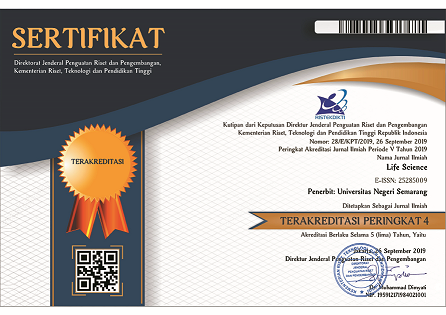Estimasi Populasi dan Habitat Monyet Ekor Panjang (Macaca fascicularis Raffles, 1821) di Desa Ngesrepbalong, Jawa Tengah
DOI:
https://doi.org/10.15294/unnesjlifesci.v13.i2.11787Keywords:
Conservation, Macaca fascicularis, Population, VegetationAbstract
Mount Ungaran leaves an important ecosystem as a habitat for various species, including long-tailed macaques (Macaca fascicularis Raffles, 1821). Long-tailed macaques (MEP) are a type of animal that is not protected according to PP No. 106 of 2018. In the IUCN, the conservation status of MEP has changed from the vulnerable category to endangered and is included in Appendix II based on CITES. Estimation of the population of a species is very necessary to provide an overview of the existence of the species in an area. There has been no research on the estimation of the population and habitat of MEP in Ngesrepbalong Village. The purpose of this study was to analyze the estimation of the MEP population and the condition of the MEP habitat in Ngesrepbalong Village, Central Java. The method used in this study was the survey method with the calculation of concentration points (concentration count). This method is used on various types of wild animals that gather in groups at observation points that have been previously determined based on the results of preliminary surveys along with the habitat conditions analyzed to produce an estimate of the MEP population and habitat at the research location. The results of the analysis of the estimated MEP population in Ngesrepbalong Village found 53 individuals in two groups at two observation points, namely Gunungsari and Separe with the percentage of the MEP population based on sex, namely 28% juveniles, 38% juveniles, and 34% adults. The increasing number of young MEP individuals indicates that the population will increase assuming a constant mortality rate. Poaching and habitat carrying capacity are the most influential factors in the difference in population numbers at the two observation points. The highest MEP encounters were at the Gunungsari observation point.
Downloads
References
Afifah, N., Jannah, R., & Ahadi R. (2021). Populasi Monyet Ekor Panjang (Macaca fascicularis) di Kawasan Hutan Wisata Kilometer Nol Sabang. Prosiding Seminar Nasional Biotik. 9(1), 106-109. http://dx.doi.org/10.22373/pbio.v9i1.11528
Afnizar, M., Mauliza, E., Zuhra, S., & Gunawan, A. (2015). Populasi Monyet Ekor Panjang (Macaca fascicularis) di Pegunungan Sawang Ba’u Kecamatan Sawang Kabupaten Aceh Selatan. Prosiding Seminar Nasional Biotik. 3(1), 184-186. http://dx.doi.org/10.22373/pbio.v3i1.2667
Chantika, M, N., Syaputra, M., & Ichsan, A, C. (2023). Karakteristik Habitat dan Pemetaan Wilayah Jelajah Monyet Ekor Panjang (Macaca fascicularis) di Blok Pemanfaatan Resort Manggelewa Kilo Bkph Tambora. Ulin: Jurnal Hutan Tropis. 7(1), 82-95. http://dx.doi.org/10.32522/ujht.v7i1.10128
Dharma, A. P., & Amirullah, G. (2019). Populasi Monyet Ekor Panjang (Macaca fascicularis) di Kawasan Batuan Kapur Jawa Barat. Wahana-Bio: Jurnal Biologi dan Pembelajarannya. 11(2), 68-76. http://dx.doi.org/10.20527/wb.v11i2.8016
Estrada A, Garber PA, Mittermeier RA, Wich S, Gouveia S, Dobrovolski R, Nekaris KAI, Nijman V, Rylands AB, Maisels F, Williamson EA, Bicca-Marques J, Fuentes A, Jerusalinsky L, Johnson S, Rodrigues de Melo F, Oliveira L, Schwitzer C, Roos C, Cheyne SM, Martins Kierulff MC, Raharivololona B, Talebi M, Ratsimbazafy J, Supriatna J, Boonratana R, Wedana M, Setiawan A. (2018). Primates in peril: The significance of Brazil, Madagascar, Indonesia and the Democratic Republic of the Congo for global primate conservation. PeerJ, 6, 1–57. https://doi.org/10.7717/peerj.4869
Eudey, A., Kumar, A., Singh, M., & Boonratana. 2020. Macaca fascicularis. The IUCN Red List of Threatened Species 2020: E.T12551A17949449.
Fajrin, M. L., Supartono, T., & Hendrayana, Y. (2022). Struktur Populasi Monyet Ekor Panjang (Macaca fascicularis) di Habitat Terisolasi Taman Nasional Gunung Ciremai. Wana Raksa: Jurnal Kehutanan dan Lingkungan. 16(2), 44-51. https://doi.org/10.25134/wanaraksa.v16i02.9020
Hafsari R., Hastiana Y., & Windarti. (2014). Studi Pakan Monyet Ekor Panjang (Macaca fascicularis Raffles, 1821) di Taman Wisata Alam Punti Kayu Palembang Sumatera Selatan. Sylva: Jurnal Penelitian Ilmu-Ilmu Kehutanan. 3(1), 7-11. https://doi.org/10.32502/sylva.v3i1.156
Jannah, F. N., Erianto., & Dewantara, I. 2019. Kepadatan dan Struktur Populasi Monyet Ekor Panjang (Macaca fascicularis) di Kawasan Hutan Kota Teluk Akar Bergantung Ketapang Kalimantan Barat. Jurnal Hutan Lestari. 7(2), 761-772. https://doi.org/10.26418/jhl.v7i2.33694
Mariati. 2017. Studi Populasi dan Parameter Demografi Lutung (Trachypitechus auratus) di Jalur ODTWA Air Terjun Jeruk Manis Resort Kembang Kuning Taman Nasional Gunung Rinjani. Mataram [Unpublished]. Universitas Mataram.
Nugroho, A., Noviani, W., & Widyastuti, D.A. (2019). Karakteristik dan Pemanfaatan Tipe Habitat Rhopalocera di Desa Ngesrepbalong Kabupaten Kendal. Bioma: Jurnal Ilmiah Biologi. 8(2) 351-366. https://doi.org/10.26877/bioma.v8i2.4942
Rahayuningsih M., Nugroho EK., & Retnaningsih., A. (2017). The nest characteristics of Wreathed Hornbill (Rhyticeros undulatus) in Mount Ungaran, Central Java, Indonesia. Biodiversitas 18 (3): 1130-1134. https://doi.org/10.13057/biodiv/d180334
Risdiyansyah., Harianto, S.P., & Nurcahyani, N. (2014). Studi populasi monyet ekor panjang (Macaca fascicularis) di Pulau Condong Darat Desa Rangai Kecamatan Ketibung Kabupaten Lampung Selatan. Jurnal Sylva Lestari. 2(1), 41-48. https://doi.org/10.23960/JSL1241-48
Rizaldy, M. R., Haryono, T., & Faizah, U. (2016). Aktivitas Makan Monyet Ekor Panjang (Macaca fascicularis) di Hutan Nepa Kabupaten Sampang Madura. LenteraBio. 5(1), 66-73. http://ejournal.unesa.ac.id/index.php/lenterabio
Santosa, Y., Kartono, A.P., & Kusmardiastuti. (2010). Penentuan Kuota Panen Studi Populasi Monyet Ekor Panjang (Macaca fascicularis) Berdasarkan Parameter Demografi [Master Theses, Institut Pertanian Bogor. IPB Campus Repository. https://repository.ipb.ac.id/jspui/handle/123456789/58788
Sari, F. N. I., Baskoro, K., & Hadi, M. (2020). Estimasi populasi dan vegetasi habitat Lutung Jawa (Trachypithecus auratus E. Geoffrey 1812) di Gunung Ungaran, Jawa Tengah. Jurnal Biologi Tropika, 3(2), 47–56. https://doi.org/10.14710/jbt.3.2.47-56
Sayektiningsih, T., & Broto, B. (2021). An overview of international trade of Macaca fascicularis from Indonesia based on the CITES trade database. IOP Conference Series: Earth and Environmental Science, 914(1). https://doi.org/10.1088/1755-1315/914/1/012013
Subiarsyah, M. I., Soma I, G., & Suatha, I. K. (2014). Struktur Populasi Monyet Ekor Panjang di Kawasan Pura Batu Pageh, Ungasan, Badung, Bali. Indonesia Medicus Veterinus. 3(3), 183-191. https://ojs.unud.ac.id/index.php/imv/article/view/11073
Sumarto, S., & Koneri, R. 2016. Ekologi Hewan. CV. Patra Media Grafindo.
Utami, N, R., Rahayuningsih, M., Alighiri, D., Nugraha, S, B., Yuwono, S., & Arifin, M, S. (2022). Kekayaan Jenis Tanaman Berpotensi Atsiri di Desa Ngesrepbalong, Kabupaten Kendal. Book Chapter Kimia Jilid 1.












